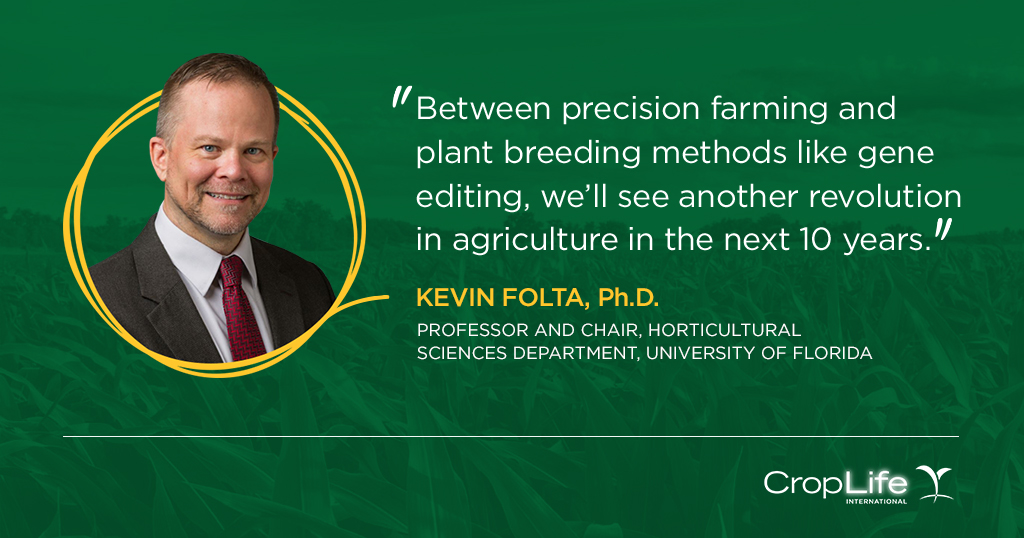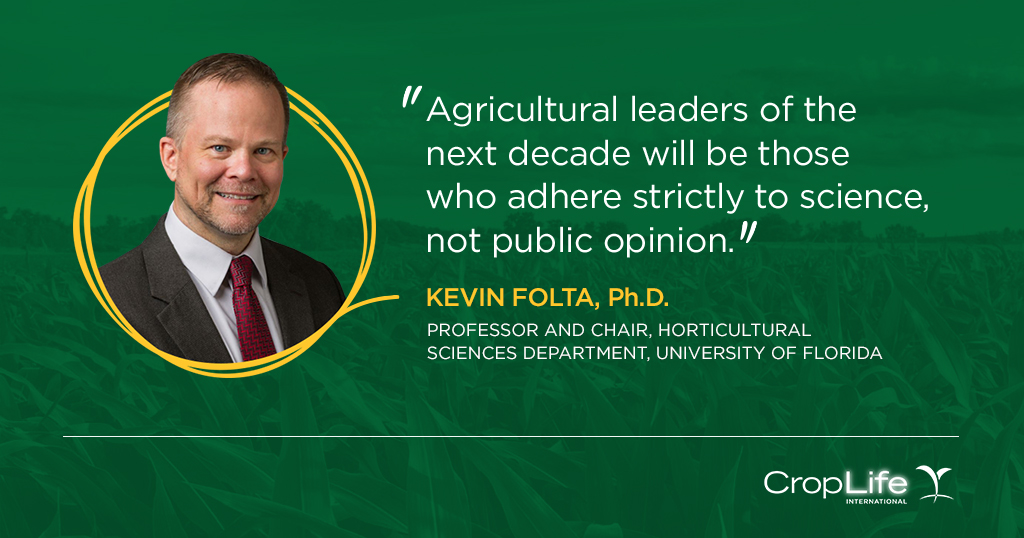By: CropLife International
What does the future hold for plant biotechnology research and development (R&D)? Between gene editing and precision farming, Dr. Kevin Folta, professor and chair of the University of Florida’s Horticultural Sciences Department, explains why he believes we’re on the cusp of another revolution in agriculture.
Can you discuss the importance of biotechnology at large?
Modern biotechnology is the ability to produce a needed trait in a much shorter time or introduce traits that you couldn’t get otherwise in traditional plant breeding. It’s about agility, precision and speed. Agriculture cannot advance to the level we need without it.
How far have we come in biotech R&D?
Most breakthroughs have been in medicine, such as the development of antibodies and reengineered viruses against cancer. But for plants, we’ve been paralyzed in some ways due to slow market acceptance in some markets. Moreover, plant biotechnology has been focused on major agronomic crops like maize and soybean. The 1996 me says ‘it’s a travesty.’ We could be solving every crop problem with biotechnology, but we’re not due to lack of consumer acceptance, government mandates, high costs of regulation and bad public information. But we can fix this!
What’s in the plant biotech pipeline?
Without question, gene editing. This allows us to inactivate genes from plants to produce desirable traits. It’s the same process as traditional plant breeding but much faster and more efficient. Every company and university lab is doing gene editing. Improving plant disease resistance is the biggest focus, but other applications, such as the removal of negative flavors and controlling flowering (more or never), are also being pursued. Gene editing is the biggest leap forward in plant biotechnology, where we’ve been taking baby steps for decades.
What are the advantages of gene editing versus other forms of biotechnology?
With gene editing, we can create changes we need without introducing foreign DNA in the final product. Although there’s nothing wrong with adding DNA, gene editing does not do so. That contrasts with transgenic modification, where new genes are introduced (sometimes from other species) and RNA interference (RNAi), where something is added to turn off or dial down gene expression. Also, it only takes a few months to a few years to create a new plant with gene editing as opposed to the incremental changes over time with traditional plant breeding or the 5-15 years it takes to cut through regulatory barriers with transgenics.
Also, since gene editing is on par with traditional breeding, there is no need to analyze products created by it under the old regulatory framework. It’s simply a different path to the same end, like driving versus taking a train to the same destination; we eliminate certain traits in both cases. That means we can speed up the regulatory approval process for gene-edited crops. For transgenic crops, this process can take 10-15 years, which is why developers are moving more toward gene editing and RNAi.
Will consumer acceptance of biotechnology increase?
Consumers want cheap, fast and good food. Biotechnology will help supply that. It will be a game changer in the developing world. The industrialized world will benefit from solving major problems like citrus greening disease in citrus fruits and diseases in avocado and American chestnut trees that threaten the supply of these foods. Plus, there are positive things biotechnology can do that appeals to the values of all: increase the safety and accessibility of food, reduce poverty and enhance environmental sustainability. Once those boxes are checked, it will be hard for consumers to deny the efficacy of biotechnology. But we must go beyond major crops.
What’s the difference between private and public sector biotech R&D?
The private sector is on a super highway and the public on a dirt road. We all want to succeed with gene editing, but the private sector grabbed it and ran with it, whereas public resources are thin. There is a competitive edge in the private sector, which spurs innovation. American companies and foreign governments, for instance, have invested heavily in gene editing technologies. This is the next moon race and public sector science is slower getting out of the gate.
How important is plant biotech R&D?
It’s critical. Countries like China have invested billions of dollars to get going in this sector. On the other hand, places like the European Union are way behind because of policies that have restricted approvals and research on biotech crops. Agricultural leaders of the next decade will be those who adhere strictly to science, not public opinion. We want to help people and solve problems. That takes technology, not non-science-based policy.
How much more will biotechnology be utilized in agriculture?
Between gene editing and precision farming, we’ll see another revolution in agriculture in the next 10 years. It will be a very different ball game … unless we regulate things to death and stop it. If not, we’ll add tremendous amounts of technology and precision to farming.
This article and the images included were published and created by CropLife International. See original post here.


